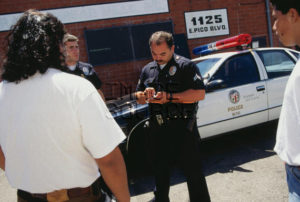By George Kennedy
On April 12, 2016, the Fourth Circuit issued its published opinion in the case of United States v. Bailey. The Fourth Circuit vacated a conviction for carjacking in violation of 18 U.S.C. § 2119, finding there was insufficient evidence to establish that Defendant had the specific intent necessary to sustain a federal carjacking conviction.
High-Speed Police Pursuit and Subsequent Carjacking
On the night of April 17, 2014 in Durham, North Carolina, a police officer observed Defendant Kenneth Lee Bailey, Jr., operating a vehicle with its tag lights out. The officer decided to make a traffic stop, and accordingly maneuvered behind Defendant’s car and turned on the lights of her patrol car. At this point, Defendant sped up and darted down a one-way street in excess of 25 miles per hour above the posted speed limit. The police officer did not follow Defendant down the one-way street, out of a concern for the safety of other motorists, but instead followed Defendant from a parallel street.
Moments later, the officer came upon Defendant’s car which had crashed head-on into a stone wall. The police officer approached the scene of the accident and heard the cries of a child. While the officer went to check on the other passengers in Defendant’s car, Defendant fled the scene on foot to a nearby McDonald’s. After verifying that all passengers were unharmed, the officer continued her pursuit of Defendant. The officer reached the McDonald’s, where the officer discovered a man inside frantically screaming that his truck had been stolen.
At trial, an eyewitness testified that Defendant had stolen his truck in the parking lot of the McDonald’s. According to the testimony, Defendant approached the witness’s car and asked the witness for a ride, promising payment. When the witness refused, Defendant forced his way in, told the witness to “drive, drive, drive” and placed something “hard and cold” to the back of the witness’s neck. Fearing for his life, the witness leaped from the truck, and Defendant then went to the driver’s seat and drove witness’s truck away from the McDonald’s. After another high-speed pursuit, police officers finally caught up with Defendant and arrested him.
Trial at the District Court and Assignments of Error
At trial, the jury found Defendant guilty of carjacking in violation of 18 U.S.C. § 2119 and the district court sentenced Defendant to 106 months in prison. During the trial, however, no witness testified that they had seen Defendant with a weapon. Defendant appealed, arguing that there was insufficient evidence to support the jury’s verdict that he was guilty of carjacking as defined under 18 U.S.C. § 2119. Specifically, Defendant asserted that evidence was lacking to establish that Defendant possessed the specific intent required to sustain a carjacking conviction under the federal carjacking statute.
Fourth Circuit Vacates the Judgment on Sufficiency of Evidence Grounds
The Fourth Circuit held that the government failed to proffer sufficient evidence to sustain a federal carjacking conviction against Defendant, specifically in regards to the intent element. Under 18 U.S.C. § 2119, a person commits the crime of carjacking if he, “with the intent to cause death or serious bodily harm[,] takes a motor vehicle . . . from the person or presence of another by force and violence or by intimidation, or attempts to do so.” To satisfy the specific intent element of the crime, the government must show that the defendant “was conditionally prepared to” kill or seriously harm the driver if the driver “failed to relinquish the vehicle.”
To explain why Defendant lacked the requisite intent to sustain a federal carjacking conviction, the Fourth Circuit first looked to precedent. The Court cited to ten different cases in which federal carjacking convictions were upheld and found that in each case, the Defendant threatened his or her victim with a real weapon and/or physically assaulted his or her victim. Therefore, the Fourth Circuit found reason to distinguish the case at bar from precedent since the Defendant in this case did not physically assault his victims nor was there evidence that Defendant had ever used a real weapon to threaten his victims. Instead, there was only evidence that Defendant had placed something “hard and cold” to a victim’s neck. From this evidence, the Fourth Circuit concluded that while Defendant clearly meant to scare his victim there was no evidence to support a finding that Defendant was prepared to kill or seriously harm his victim, as required under 18 U.S.C. § 2119.
As additional support, the Fourth Circuit looked to the U.S. Supreme Court case of United States v. Holloway. There, the Supreme Court held that “an empty threat, or intimidating bluff,. . . standing on its own is not enough to satisfy § 2119’s specific intent element.” The Fourth Circuit found that the language from Holloway was controlling here. Since there was no evidence presented that Defendant was in possession of a gun or any other weapon during the carjacking, there was no evidence to suggest that Defendant made anything but an empty threat when he pressed the “hard and cold” object to his victim’s neck. The Fourth Circuit characterized Defendant’s threats as a mere “bluff,” providing insufficient support for a reasonable jury to conclude that Defendant possessed the intent to kill or seriously harm his victim, as required by the federal carjacking statute.
Vacated and Remanded
Accordingly, the Fourth Circuit vacated Defendant’s conviction and remanded the case to the district court for a judgment of acquittal.






